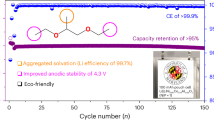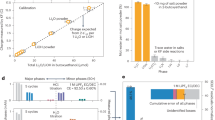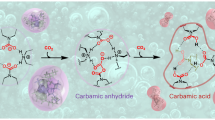Abstract
When lithium–oxygen batteries discharge, O2 is reduced at the cathode to form solid Li2O2. Understanding the fundamental mechanism of O2 reduction in aprotic solvents is therefore essential to realizing their technological potential. Two different models have been proposed for Li2O2 formation, involving either solution or electrode surface routes. Here, we describe a single unified mechanism, which, unlike previous models, can explain O2 reduction across the whole range of solvents and for which the two previous models are limiting cases. We observe that the solvent influences O2 reduction through its effect on the solubility of LiO2, or, more precisely, the free energy of the reaction LiO2* ⇌ Li(sol)+ + O2−(sol) + ion pairs + higher aggregates (clusters). The unified mechanism shows that low-donor-number solvents are likely to lead to premature cell death, and that the future direction of research for lithium–oxygen batteries should focus on the search for new, stable, high-donor-number electrolytes, because they can support higher capacities and can better sustain discharge.
This is a preview of subscription content, access via your institution
Access options
Subscribe to this journal
Receive 12 print issues and online access
$259.00 per year
only $21.58 per issue
Buy this article
- Purchase on Springer Link
- Instant access to full article PDF
Prices may be subject to local taxes which are calculated during checkout







Similar content being viewed by others
Change history
20 November 2014
In the version of this Article originally published, the author list was incorrectly ordered. Jean-Marie Tarascon should have appeared as the penultimate name. This has now been corrected in all online versions of the Article.
References
Black, R., Adams, B. & Nazar, L. F. Non-aqueous and hybrid Li–O2 batteries. Adv. Energy Mater. 2, 801–815 (2012).
Bruce, P. G., Freunberger, S. A., Hardwick, L. J. & Tarascon, J-M. Li–O2 and Li–S batteries with high energy storage. Nature Mater. 11, 19–29 (2012).
Choi, N-S. et al. Challenges facing lithium batteries and electrical double-layer capacitors. Angew. Chem. Int. Ed. 51, 9994–10024 (2012).
Shao, Y. Y. et al. Electrocatalysts for nonaqueous lithium–air batteries: status, challenges, and perspective. ACS Catal. 2, 844–857 (2012).
Thackeray, M. M., Chan, M. K. Y., Trahey, L., Kirklin, S. & Wolverton, C. A vision for designing high energy, hybrid Li-ion/Li–O2 cells. J. Phys. Chem. Lett. 4, 3607–3611 (2013).
Girishkumar, G., McCloskey, B., Luntz, A. C., Swanson, S. & Wilcke, W. Lithium–air battery: promise and challenges. J. Phys. Chem. Lett. 1, 2193–2203 (2010).
Lu, Y-C. et al. Lithium–oxygen batteries: bridging mechanistic understanding and battery performance. Energy Environ. Sci. 6, 750–768 (2013).
Garcia-Araez, N. & Novák, P. Critical aspects in the development of lithium–air batteries. J. Solid State Electrochem. 17, 1793–1807 (2013).
Li, F., Zhang, T. & Zhou, H. Challenges of non-aqueous Li–O2 batteries: electrolytes, catalysts, and anodes. Energy Environ. Sci. 6, 1125–1141 (2013).
Wang, Z-L., Xu, D., Xu, J-J. & Zhang, X-B. Oxygen electrocatalysts in metal–air batteries: from aqueous to nonaqueous electrolytes. Chem. Soc. Rev. http://dx.doi.org/10.1039/C3CS60248F (2014).
McCloskey, B. D., Scheffler, R., Speidel, A., Girishkumar, G. & Luntz, A. C. On the mechanism of nonaqueous Li–O2 electrochemistry on C and its kinetic overpotentials: some implications for Li–air batteries. J. Phys. Chem. C 116, 23897–23905 (2012).
Viswanathan, V. et al. Li–O2 kinetic overpotentials: Tafel plots from experiment and first-principles theory. J. Phys. Chem. Lett. 4, 556–560 (2013).
Lu, J. et al. A nanostructured cathode architecture for low charge overpotential in lithium–oxygen batteries. Nature Commun. 4, 2383 (2013).
Laoire, C. O., Mukerjee, S., Abraham, K. M., Plichta, E. J. & Hendrickson, M. A. Influence of nonaqueous solvents on the electrochemistry of oxygen in the rechargeable lithium–air battery. J. Phys. Chem. C 114, 9178–9186 (2010).
Allen, C. J. et al. Oxygen reduction reactions in ionic liquids and the formulation of a general ORR mechanism for Li–air batteries. J. Phys. Chem. C 116, 20755–20764 (2012).
Trahan, M. J., Mukerjee, S., Plichta, E. J., Hendrickson, M. A. & Abraham, K. M. Studies of Li–air cells utilizing dimethyl sulfoxide-based electrolyte. J. Electrochem. Soc. 160, A259–A267 (2013).
Sharon, D. et al. Oxidation of dimethyl sulfoxide solutions by electrochemical reduction of oxygen. J. Phys. Chem. Lett. 4, 3115–3119 (2013).
Herranz, J., Garsuch, A. & Gasteiger, H. A. Using rotating ring disc electrode voltammetry to quantify the superoxide radical stability of aprotic Li–air battery electrolytes. J. Phys. Chem. C 116, 19084–19094 (2012).
Zhang, T. & Zhou, H. A reversible long-life lithium–air battery in ambient air. Nature Commun. 4, 1817 (2013).
Walker, W. et al. A rechargeable Li–O2 battery using a lithium nitrate/N,N-dimethylactamide electrolyte. J. Am. Chem. Soc. 135, 2076–2079 (2013).
Adams, B. D. et al. Current density dependence of peroxide formation in the Li–O2 battery and its effect on charge. Energy Environ. Sci. 6, 1772–1778 (2013).
Hummelshoj, J. S., Luntz, A. C. & Norskov, J. K. Theoretical evidence for low kinetic overpotentials in Li–O2 electrochemistry. J. Chem. Phys. 138, 034703–034712 (2013).
Jung, H. G., Hassoun, J., Park, J. B., Sun, Y. K. & Scrosati, B. An improved high-performance lithium–air battery. Nature Chem. 4, 579–585 (2012).
Mitchell, R. R., Gallant, B. M., Shao-Horn, Y. & Thompson, C. V. Mechanisms of morphological evolution of Li2O2 particles during electrochemical growth. J. Phys. Chem. Lett. 4, 1060–1064 (2013).
Nasybulin, E. et al. Effects of electrolyte salts on the performance of Li–O2 batteries. J. Phys. Chem. C 117, 2635–2645 (2013).
Nasybulin, E. et al. Electrocatalytic properties of poly(3,4-ethylenedioxythiophene) (PEDOT) in Li–O2 battery. Electrochem. Commun. 29, 63–66 (2013).
Kang, S., Mo, Y., Ong, S. P. & Ceder, G. A facile mechanism for recharging Li2O2 in Li–O2 batteries. Chem. Mater. 25, 3328–3336 (2013).
Suntivich, J. et al. Design principles for oxygen–reduction activity on perovskite oxide catalysts for fuel cells and metal–air batteries. Nature Chem. 3, 546–550 (2011).
Younesi, R., Hahlin, M., Björefors, F., Johansson, P. & Edström, K. Li–O2 battery degradation by lithium peroxide (Li2O2): a model study. Chem. Mater. 25, 77–84 (2013).
Trahey, L. et al. Synthesis, characterization, and structural modeling of high-capacity, dual functioning MnO2 electrode/electrocatalysts for Li–O2 cells. Adv. Energy Mater. 3, 75–84 (2013).
Guo, Z. et al. Ordered hierarchical mesoporous/macroporous carbon: a high performance catalyst for rechargeable Li–O2 batteries. Adv. Mater. 25, 5668–5672 (2013).
Li, L. & Manthiram, A. Dual-electrolyte lithium–air batteries: influence of catalyst, temperature, and solid-electrolyte conductivity on the efficiency and power density. J. Mater. Chem. A 1, 5121–5127 (2013).
Zhang, T. et al. A novel high energy density rechargeable lithium/air battery. Chem. Commun. 46, 1661–1663 (2010).
Xu, J-J., Wang, Z-L., Xu, D., Zhang, L-L. & Zhang, X-B. Tailoring deposition and morphology of discharge products towards high-rate and long-life lithium–oxygen batteries. Nature Commun. 4, 2438 (2013).
Younesi, R. et al. Ether based electrolyte, LiB(CN)4 salt and binder degradation in the Li–O2 battery studied by hard X-ray photoelectron spectroscopy (HAXPES). J. Phys. Chem. C 116, 18597–18604 (2012).
Yang, J. et al. Evidence for lithium superoxide-like species in the discharge product of a Li–O2 battery. Phys. Chem. Chem. Phys. 15, 3764–3771 (2013).
Lu, J. et al. Synthesis and characterization of uniformly dispersed Fe3O4/Fe nanocomposite on porous carbon: application for rechargeable Li–O2 batteries. RSC Adv. 3, 8276–8285 (2013).
Veith, G. M., Nanda, J., Delmau, L. H. & Dudney, N. J. Influence of lithium salts on the discharge chemistry of Li–air cells. J. Phys. Chem. Lett. 3, 1242–1247 (2012).
Pearson, R. G. Hard and soft acids and bases. J. Am. Chem. Soc. 85, 3533–3539 (1963).
Sawyer, D. T., Chlericato, G., Angelis, C. T., Nanni, E. J. & Tsuchiya, T. Effects of media and electrode materials on the electrochemical reduction of dioxygen. Anal. Chem. 54, 1720–1724 (1982).
Vasudevan, D. & Wendt, H. Electroreduction of oxygen in aprotic media. J. Electroanal. Chem. 392, 69–74 (1995).
Nissim, R., Batchelor-McAuley, C., Li, Q. & Compton, R. G. The anthraquinone mediated one-electron reduction of oxygen in acetonitrile. J. Electroanal. Chem. 681, 44–48 (2012).
Laoire, C. O., Mukerjee, S., Abraham, K. M., Plichta, E. J. & Hendrickson, M. A. Elucidating the mechanism of oxygen reduction for lithium–air battery applications. J. Phys. Chem. C 113, 20127–20134 (2009).
Lu, Y. C., Gasteiger, H. A., Parent, M. C., Chiloyan, V. & Shao-Horn, Y. The influence of catalysts on discharge and charge voltages of rechargeable Li–oxygen batteries. Electrochem. Solid-State Lett. 13, A69–A72 (2010).
Bard, A. J. & Faulkner, L. R. Electrochemical Methods: Fundamentals and Applications 2nd edn (Wiley, 2001).
Peng, Z. et al. Oxygen reactions in a non-aqueous Li+ electrolyte. Angew. Chem. Int. Ed. 50, 6351–6355 (2011).
Pasgreta, E. et al. Ligand-exchange processes on solvated lithium cations: DMSO and water/DMSO mixtures. ChemPhysChem 8, 1315–1320 (2007).
Bryantsev, V. Calculation of solvation free energies of Li+ and O2− ions and neutral lithium–oxygen compounds in acetonitrile using mixed cluster/continuum models. Theor. Chem. Acc. 131, 1–11 (2012).
Das, U., Lau, K. C., Redfern, P. C. & Curtiss, L. A. Structure and stability of lithium superoxide clusters and relevance to Li–O2 batteries. J. Phys. Chem. Lett. 5, 813–819 (2014).
Bryantsev, V. S. et al. Predicting solvent stability in aprotic electrolyte Li–air batteries: nucleophilic substitution by the superoxide anion radical (O2•). J. Phys. Chem. A 115, 12399–12409 (2011).
Bryantsev, V. S., Blanco, M. & Faglioni, F. Stability of lithium superoxide LiO2 in the gas phase: computational study of dimerization and disproportionation reactions. J. Phys. Chem. A 114, 8165–8169 (2010).
Horstmann, B. et al. Rate-dependent morphology of Li2O2 growth in Li–O2 batteries. J. Phys. Chem. Lett. 4, 4217–4222 (2013).
Luntz, A. C. et al. Tunneling and polaron charge transport through Li2O2 in Li–O2 batteries. J. Phys. Chem. Lett. 4, 3494–3499 (2013).
Acknowledgements
P.G.B. acknowledges financial support from the Engineering and Physical Sciences Research Council (including the SUPERGEN programme). S.A.F. acknowledges financial support from the Austrian Federal Ministry of Economy, Family and Youth and the Austrian National Foundation for Research, Technology and Development as well as the Austrian Science Fund (FWF): P26870-N19. K.D. thanks the UK EPSRC for funding and the European Union project FAMOS (FP7 ICT, contract no. 317744). The authors thank D. Larcher for discussions.
Author information
Authors and Affiliations
Contributions
L.J. and C.L. designed and performed electrochemical and Raman spectroscopy experiments and analysed the data. Z.L. discharged and performed microscopy of Li2O2 on high-surface-area cathodes. P.C.A. and B.B.P. built and maintained the Raman microscope and contributed to the Raman measurements and analysis. Y.C. performed the UV–vis spectroscopy experiments and analysed the data. P.G.B., L.J., Y.C. and S.F. interpreted the data. P.G.B. wrote the paper with contributions from L.J. The project was supervised by P.G.B., J-M.T. and K.D.
Corresponding author
Ethics declarations
Competing interests
The authors declare no competing financial interests.
Supplementary information
Supplementary information
Supplementary information (PDF 1674 kb)
Rights and permissions
About this article
Cite this article
Johnson, L., Li, C., Liu, Z. et al. The role of LiO2 solubility in O2 reduction in aprotic solvents and its consequences for Li–O2 batteries. Nature Chem 6, 1091–1099 (2014). https://doi.org/10.1038/nchem.2101
Received:
Accepted:
Published:
Issue Date:
DOI: https://doi.org/10.1038/nchem.2101
This article is cited by
-
Optimal geometrical configuration and oxidation state of cobalt cations in spinel oxides to promote the performance of Li-O2 battery
Nano Research (2024)
-
Designing an asymmetric ether-like lithium salt to enable fast-cycling high-energy lithium metal batteries
Nature Energy (2023)
-
Electrochemical surface-enhanced Raman spectroscopy
Nature Reviews Methods Primers (2023)
-
Tailoring chemical composition of solid electrolyte interphase by selective dissolution for long-life micron-sized silicon anode
Nature Communications (2023)
-
Electrolyte design for Li-ion batteries under extreme operating conditions
Nature (2023)



